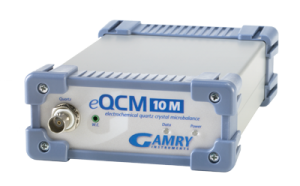Gamry Instruments is pleased to announce the publication of a manuscript highlighting the capabilities of the Gamry eQCM 10M.
The project entitled “Application of the combined electrochemical quartz crystal microbalance and probe beam deflection technique in deep eutectic solvents” uses the EQCM/PBD method for the first time applying to metal deposition/dissolution processes in deep eutectic solvents. Collaborators on this project include: A. Robert Hillman, Karl S. Ryder, Christopher J. Zaleski, Virginia Ferreira, Christopher A. Beasley, and Eric Vieil.
Following are some highlights of the publication:
- The EQCM/PBD method has for the first time been applied to metal deposition/dissolution processes in deep eutectic solvents
- The PBD responds to solution phase chemistry, while the E and QCM probes respond to interfacial processes only
- The combination of electrochemical (E), gravimetric (QCM) and optical (PBD) responses provides diagnostic capability
- EQCM/PBD data reveal the influence of Ag/Cl− complex speciation in the high chloride concentration ionic liquid
- The PBD response reveals the intrusion of solubility limitations into Sn anodic stripping
Abstract
 The electrochemical quartz crystal microbalance (EQCM) and probe beam deflection (PBD) have been widely used to study interfacial processes in molecular solvent-based electrolytes. However, there has been limited use of the EQCM and none of PBD in room temperature ionic liquids, including deep eutectic solvents (DES). Here we explore the use of the combined EQCM/PBD technique to the study of Ag and Sn electrodeposition from a DES comprising a 1:2 mixture of choline chloride and ethylene glycol. While overcoming the effect of viscous loss in the acoustic wave (EQCM) part of the experiment is understood, the optical (PBD) technique fails to provide a meaningful response in slow scan rate voltammetric experiments; this contrasts sharply with the straightforward behavior seen in aqueous media. Solution transport considerations reveal this to be a consequence of long surface-to-beam transit times in the viscous DES. The problem can be overcome by operating at scan rates 1-2 orders of magnitude slower, permitting application of this powerful technique to novel media of technological interest. The PBD responses reveal unanticipated chemical effects: multiple complexes in the Ag system and solubility limitations in the Sn system, neither of which is evident from the electrochemical or QCM responses.
The electrochemical quartz crystal microbalance (EQCM) and probe beam deflection (PBD) have been widely used to study interfacial processes in molecular solvent-based electrolytes. However, there has been limited use of the EQCM and none of PBD in room temperature ionic liquids, including deep eutectic solvents (DES). Here we explore the use of the combined EQCM/PBD technique to the study of Ag and Sn electrodeposition from a DES comprising a 1:2 mixture of choline chloride and ethylene glycol. While overcoming the effect of viscous loss in the acoustic wave (EQCM) part of the experiment is understood, the optical (PBD) technique fails to provide a meaningful response in slow scan rate voltammetric experiments; this contrasts sharply with the straightforward behavior seen in aqueous media. Solution transport considerations reveal this to be a consequence of long surface-to-beam transit times in the viscous DES. The problem can be overcome by operating at scan rates 1-2 orders of magnitude slower, permitting application of this powerful technique to novel media of technological interest. The PBD responses reveal unanticipated chemical effects: multiple complexes in the Ag system and solubility limitations in the Sn system, neither of which is evident from the electrochemical or QCM responses.
To download the complete publication, please visit ScienceDirect.com.
Contact Information:
Gamry Instruments
734 Louis Drive
Warminster, PA 18974
215-682-9330
http://www.Gamry.com
